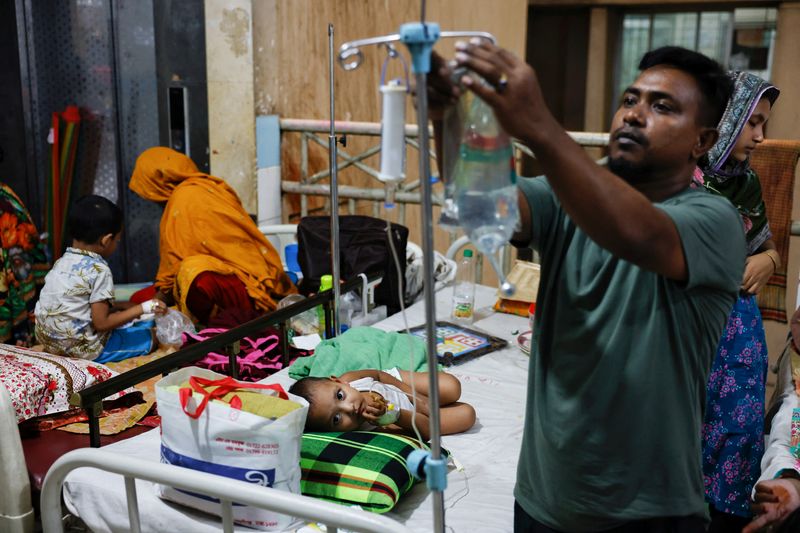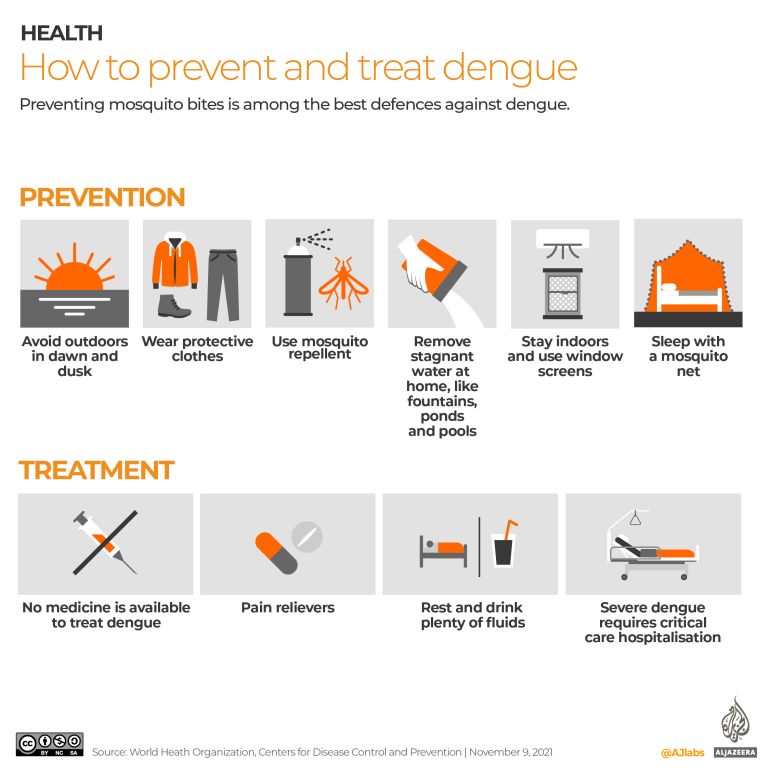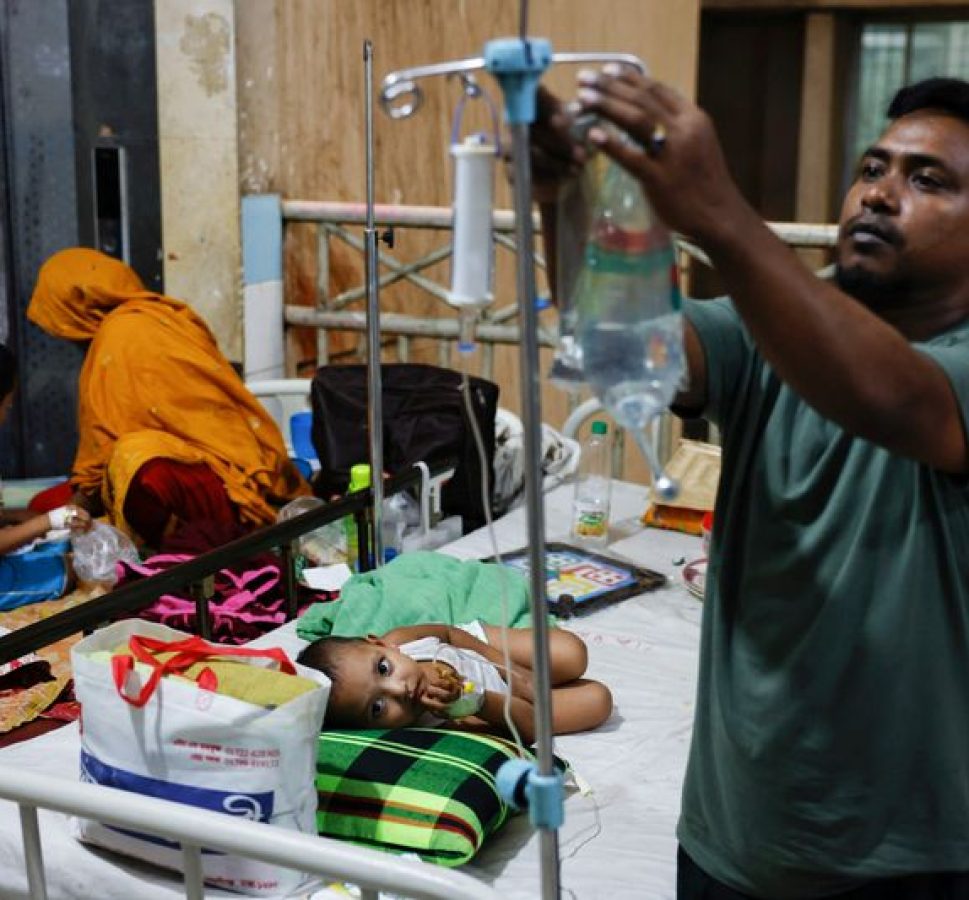
The densely populated country faces its worst-ever outbreak in history, with more than 1,500 dead and hospitals packed to the brim.The densely populated country faces its worst-ever outbreak in history, with more than 1,500 dead and hospitals packed to the brim.
Dhaka, Bangladesh – Every time Mosammat Mayna enters the dengue ward at Mugda Hospital in Bangladesh’s capital, sorrow and fear grip her mind.
The 23-year-old has been working as a cleaner in the hospital for just about a month, and the only reason she got the job was because her sister, Maria Ratna, died of dengue last month while doing her duty as a cleaner in the same ward.
“My sister worked relentlessly for months during this year’s dengue outbreak and eventually caught the disease. After she died, the hospital authority offered me her job,” Mayna told Al Jazeera.
“Our family was devastated by Ratna’s death, but since I was out of work, I took the offer despite being very scared.”

Bangladesh is undergoing its worst-ever dengue outbreak in history, with hospitals packed to the brim and the death toll rising. Last Wednesday, the country recorded 24 deaths – the highest in a day – from the mosquito-borne disease.
While the disease does not spread from person to person, a mosquito that bites an infected patient then becomes a carrier, and can transmit dengue to others it bites. That makes places with a high concentration of dengue patients — such as the hospital where Mayna works — more dangerous for those who are not yet infected.
Health experts are alarmed as dengue usually subsides in the South Asian region when the annual monsoon rains stop by the end of September.
As of Monday, at least 1,549 people – including 156 children, from newborns up to those aged 15 – have died of the disease in Bangladesh, which has recorded a total of 301,255 dengue cases this year, according to the government’s Directorate General of Health Service (DGHS).
The record deaths are roughly five times last year’s tally of 281 fatalities – the highest in a single year in Bangladesh’s history – until the outbreak this year. The previous highest number of cases in one year – 1,01,354 – was reported back in 2019.
“I have never witnessed a dengue outbreak of this proportion,” Mugda Hospital’s director Dr Mohammed Niatuzzaman told Al Jazeera, adding that patients were streaming in from across the densely-populated country. “It’s very unusual to see such a large number of dengue patients in November.”
Outbreak of ‘epidemic’ proportion
Dengue outbreaks earlier were largely confined to heavily populated urban centres such as the capital Dhaka, home to more than 23 million people. Experts say the disease this year has reached every district, including the rural areas.
The DGHS data says 65 percent of the cases reported this year were from outside of Dhaka – the first time the capital had fewer cases than the rest of the country.
Sohaila Begum came to Mugda Hospital from the southern district of Patuakhali with her 11-year-old daughter, who has had a high fever for more than a week now. With no beds available, they are staying in the hospital’s corridors.
“When her fever got worse, doctors at the district hospital told us to immediately take her to any good hospital in the cities,” she told Al Jazeera, adding that her daughter’s situation had improved.
“We came to Dhaka but are now running out of money. Everything is so expensive here. We will be in trouble if we stay longer.”

Public health expert and former DGHS director Dr ANM Nuruzzaman told Al Jazeera this year’s outbreak is no less than an epidemic.
“The problem is the severity of dengue has sort of gone out of the public and media’s radar as the country is going through a political turmoil ahead of the next election,” he said.
Bangladesh is expected to hold the general election on January 7 amid political uncertainty and violence gripping the country, as the main opposition Bangladesh Nationalist Party (BNP) is demanding the removal of the ruling Awami League government and the installation of a caretaker administration to ensure free and fair polls.
“Dengue is a serious crisis as the pattern and severity of the disease have changed and turned to worse. The government should have declared it a public emergency long ago,” said Nuruzzaman.
Government officials claim that they have done everything to check dengue’s spread and that declaring it a public emergency or epidemic would not have made much difference.
“All the government hospitals across the country were instructed to open special dengue wards in the beginning of August. The health ministry also allocated an emergency budget to fight the outbreak,” Dr Mohammad Robed Amin, director of noncommunicable disease at DGHS, told Al Jazeera.
“The problem is our country’s healthcare system has serious limitations because we are a large population and it’s almost impossible to ensure healthcare and treatment for all,” he said.

Amin noted that cases and deaths this year are “abnormally high” for several reasons. “The first and foremost reason is the overwhelming prevalence of Den-2 type strain of dengue among the patients,” he said.
Dengue has four types: Den-1, Den-2, Den-3 and Den-4. A person becomes immune to a dengue type after infection, but not to other types.
“For the last couple of years, Bangladesh mostly had Den-3 type strains and people had developed immunity against it. But this year, over 75 percent of patients were diagnosed with Den-2 and almost all the patients who died were affected by this particular strain,” said Amin, adding that multiple studies have found that Den-2 outbreak is worse when it is followed by years of Den-3 prevalence.

Another reason behind the high fatalities is the outbreak in rural areas, he said.
“This year, the disease has spread across the country, and in rural areas, the health facilities are very scarce. Besides, most people are not aware of the severity of the illness. If you don’t get treatment on time, it can get fatal. And that has happened in many areas.”
What caused the record deaths
Meanwhile, entomologists say they may have found the possible reason behind this year’s record outbreak.
Kabirul Bashar, professor of medical entomology at Bangladesh’s Jahangirnagar University, told Al Jazeera that the pattern of dengue subsiding by September changed last year when the disease reached its peak in October and caused 86 deaths. A year before that in 2021, that number was 22.
“We rang an alarm last year, saying the very pattern of the disease has changed. Now dengue is not a disease associated with monsoon anymore, it’s a year-long thing,” said Bashar, who is also the lone scientific expert on the country’s National Anti-Dengue Committee.
The scientist said climate change is altering patterns in temperature, rainfall and other natural phenomenon.
Advertisement
“Now, we see almost monsoon-like consistent rain throughout October and early November. It changes the breeding and lifecycle of the Aedes mosquito populations,” he said, referring to the type of mosquito that carries dengue.

Dengue is mostly prevalent in South and Southeast Asia between June and September, when stagnant water provides the ideal habitat for the Aedes mosquito, which usually breeds in clean water and feeds during the day.
But in a groundbreaking finding, Bashar, who has been studying mosquitoes for more than two decades, discovered that the mosquitos now breed even in dirty sewers and in saline seawater.
“So, on the one hand, you have unusually consistent rains during the off-season that provide an ideal ground for their breeding and, on the other hand, you have the mosquitoes broadening their horizon for reproduction. It’s a double whammy,” he told Al Jazeera.
Entomologists also discovered that the two most widely used insecticides, malathion and temephos, had become “useless” against Aedes mosquitoes in Bangladesh.
“These two insecticides have turned sub-insecticide, losing their efficacy against mosquitoes because they have developed resistance,” said Md Golam Sharower, professor at the National Institute of Preventive and Social Medicine.
“Unfortunately, most of our city corporations across the country still use these two insecticides, which help very little in controlling the mosquito population.”
Advertisement
Bashar said the government needs to take a full-fledged five-year plan to control the spread of dengue and eventually eradicate the Aedes mosquito population.
“The disease will only get worse in the upcoming years if such a plan is not activated immediately,” he said.
Back at Dhaka’s Mugda Hospital, Mayna, overwhelmed by the unusually long dengue epidemic, has begun to rue her decision to work as a cleaner.
“I thought dengue would subside with the end of the rainy season, but patients keep coming in every day. Forget the ward beds, there is no space even in the hospital corridors,” she told Al Jazeera.
“I fear I might also end up like my sister.”






